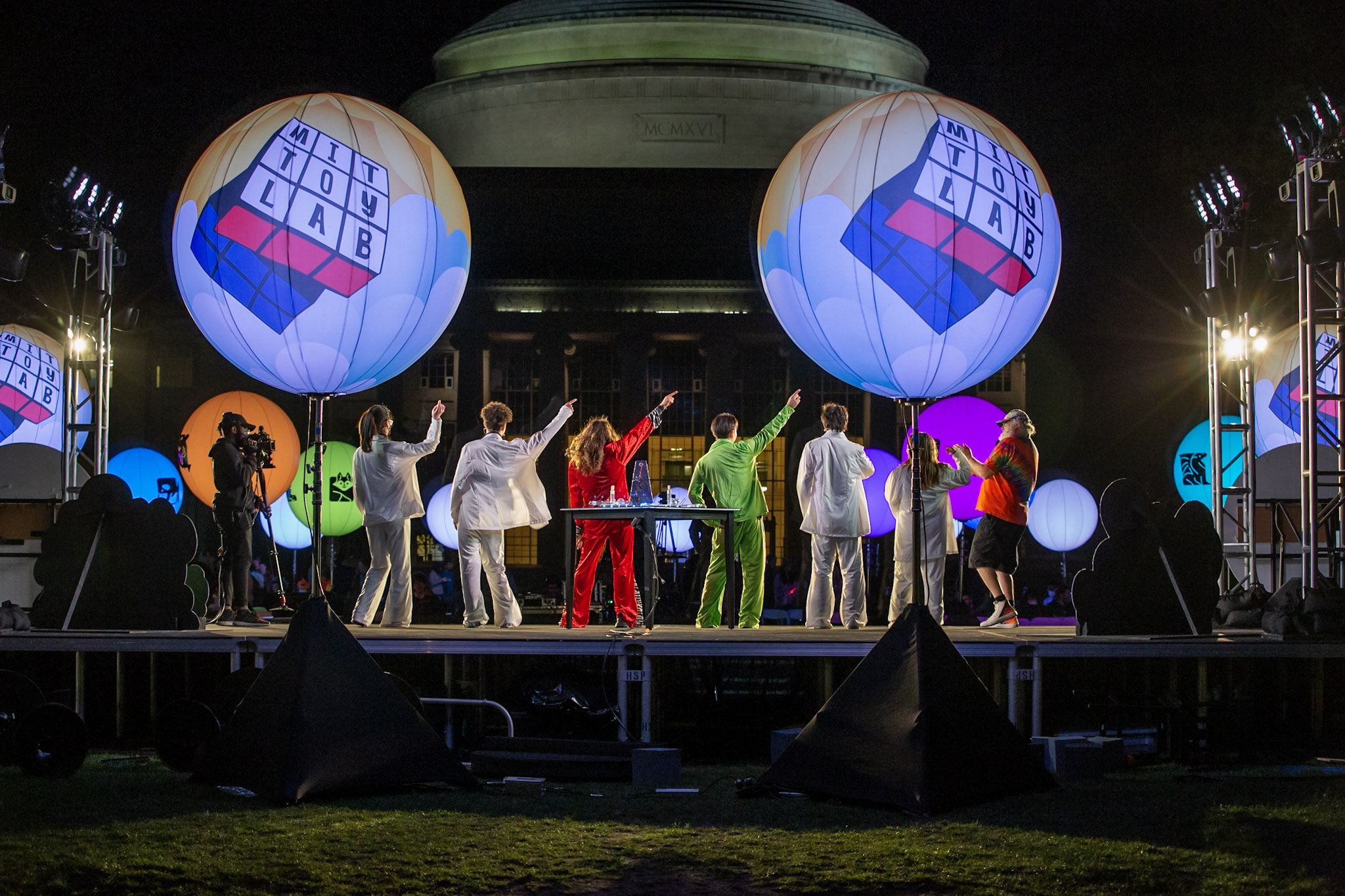First-year students take center stage on Killian Court
For the first time, students in 2.00b (Toy Product Design) performed their “PLAYsentations” live for a large audience on Killian Court.

On a chilly Monday in May, MIT’s Killian Court was transformed into a festival of fun. Over 1,200 members of the community enjoyed hot dogs, fried dough, and bouncy castles before cozying up on picnic blankets to watch the main event. First-year students took to the stage to perform skits — or “PLAYsentations” — demonstrating the toys they created this semester in mechanical engineering class 2.00b (Toy Product Design).
For the 150 students in the class, presenting in front of a large audience and in such an iconic location so early in their time at MIT was a surreal experience.
“It was such a symbolic setting. Presenting in front of the dome with the Boston skyline as our backdrop. It’s one of those moments where you realize the capacity you have as an MIT student to create something that could have an impact on the world beyond MIT,” says first-year student Grace Hutter.
The event, held on May 9, marked the first time PLAYsentations were performed live in front of an audience in Killian Court. For years, they were held in a room in Building 10 on MIT’s campus. Due to the pandemic, in 2021 the event was held in a mostly-empty Killian Court so the entire class could be together for the first time all semester.
David Wallace, professor of mechanical engineering and instructor of 2.00b, saw an opportunity to include members of the extended MIT community, family, and friends in this year’s PLAYsentations. With the help of a large dedicated team, including lab manager Nathan Phipps; teaching assistants (TAs) Caleb Amanfu, Antoni Soledad, and Jordan Tappa; staff; and over 30 volunteer instructors who mentored students, Wallace planned an event focused on fun, which is only fitting for a class about toys.
“This year’s PLAYsentations had a community, fun-for-all, cathartic feeling,” says Wallace. “Children of all ages can relate to toy design, and the PLAYsentations in Killian were a festival where young, old, and in-between could celebrate engineering design.” Throughout the PLAYsentations, attendees consumed 2,200 hotdogs, 1,700 servings of fried dough, and 1,000 fried Oreos.
As dusk settled over the Charles River, it was time for students to begin presenting their toy products.
Students performed plays centered around their toy prototypes. Each team delighted the audience with their creativity and inspired engineering design. Toys included an octopus-inspired music synthesizer, a version of high striker that tests player control — not strength, a magnetic marble run, plushies that convey messages to friends at any distance, an electronic range-finding hide-and-seek game (“find the bread”), and a coral reef balancing challenge inspired by an environmental message. In all, 26 toys were introduced, running a technology gamut from traditional to high-tech.
“As a first-year student, I could not believe that I was actually presenting on Killian Court, live for everyone to see,” says Jade Durham. “If myself from one year ago could see me now, they would not believe that it was possible for me to confidently be up on that stage.”
According to Wallace, instilling confidence in students is a central goal of 2.00b.
“It’s a great opportunity to build one’s confidence, showcase accomplishments, and receive affirmation of one's efforts. By presenting in the form of a play — hence PLAYsentation — getting up in front of a large, in-person audience, and even larger audience online, just becomes fun,” explains Wallace. “The students and the audience are in it together. It’s something to look forward to, rather than stress about. And this confidence and enthusiasm can be a springboard to other professional speaking contexts.”
Typically taken in a student’s first year at MIT, 2.00b is a project-based class that introduces students to the product design process. Wallace refers to the class as a “playful boot camp.” Throughout the semester, students learn about various fabrication techniques and associated tools within the context of design.
Students are introduced to user-centric design, the product design process, sketching, computer-aided designing (CAD), and a host of design modeling materials and techniques. They learn how to apply these design techniques to a diverse range of prototyping methods, including traditional methods such as woodworking and sewing and newer methods like digital prototyping.
“I loved how each week we learned a new skill, from CAD to soldering to using machine tools and sketching,” says Adrienne Lai, a first-year student who took 2.00b.
By the end of the semester, students emerge with an online portfolio of various designs, something that often helps them secure internships and encourages them to continue designing moving forward.
“The goal is to cover a lot of firsts so students are eager to take on their next project!” adds Wallace.
After gaining some hands-on experience in the lab, students were divided into 26 teams named after animals from all ages, including dinosaurs. Each team then brainstormed toys centered on this year’s theme of “community.” Then the design and prototyping process began. Teams explored toy options, eventually deciding what toy they would create and making a final prototype.
Since Wallace and his teaching staff emphasize user-centered design, students tested toys with their intended end-users, children. Students play-tested the toys with children at the Children's Museum of Acton.
For Wallace, all of this fun serves a greater purpose. “The class takes a playful approach to realize serious, thoughtful, and inspired design outcomes, with the goal of building skills and instilling a love for engineering design that can carry over into any problem domain,” he adds.
As students were creating and user-testing their prototypes, they put on their writing hats and started preparing one- to two-minute skits to perform at PLAYsentations. With the help of the lab and teaching staff, students perfected their skits in the final weeks of the semester.
“The TAs were primarily responsible for organizing the students, the costumes, printing the graphic signage and event posters, and making special props if teams requested,” says Jordan Tappa, who alongside his fellow teaching assistants Caleb Amanfu and Antoni Soledad was also on hand to answer any design questions students had. “We spent about a month on and off ordering all the costumes, organizing them by team, and delivering them for pickup at the practice run of their presentation.”
Dressed in squirrel costumes, NASA space suits, and superhero capes, students performed these skits in front of 1,200 people at Killian Court and 2,000 unique internet addresses watching online from six continents.
The support students received from the in-person and online audience was palpable. For first-year student Kanokwan Tungkitkancharoen, it made her feel more a part of the MIT community.
“I felt seen. It was a bit scary at first, but, at the same time, thrilling to present a project that I was proud of to such a large audience,” says Tungkitkancharoen. “MIT can be an overwhelming place — there’s always so much going on. To help reconcile this feeling, I think the PLAYsentations helped me feel like I contributed a little something to the school.”





































